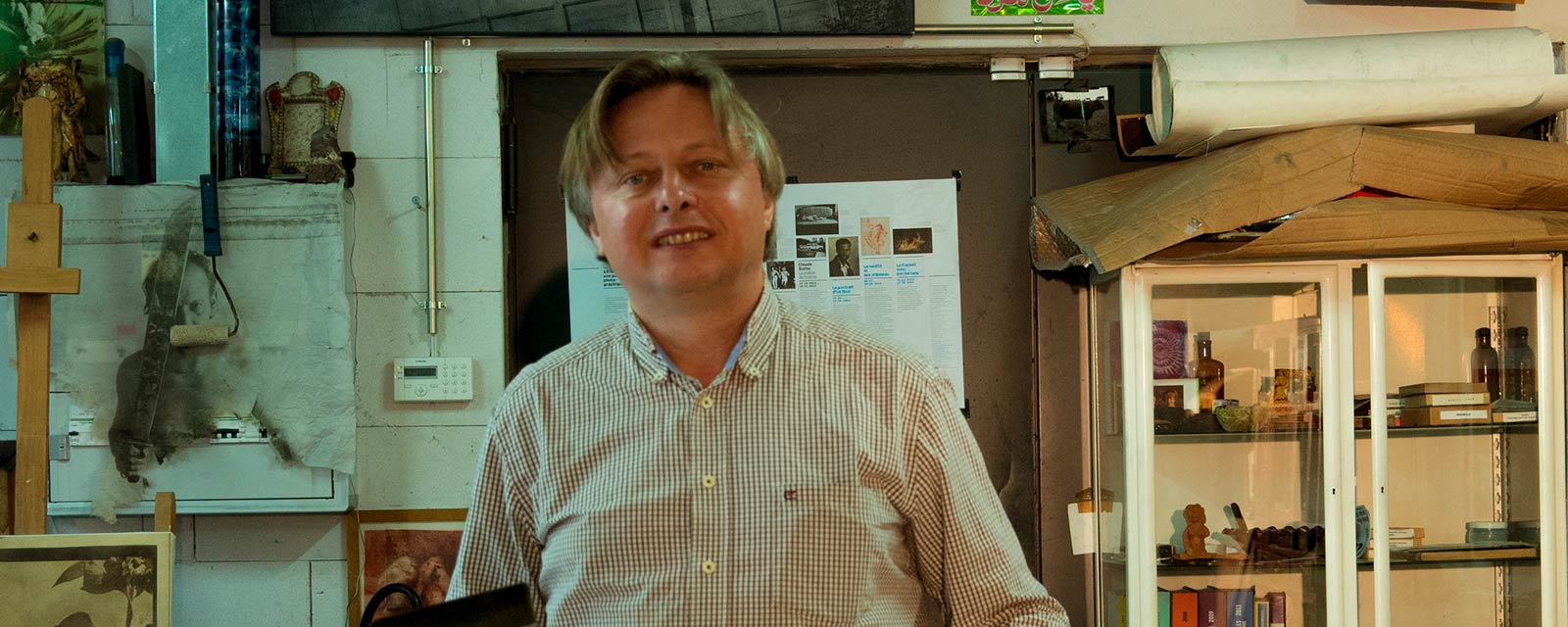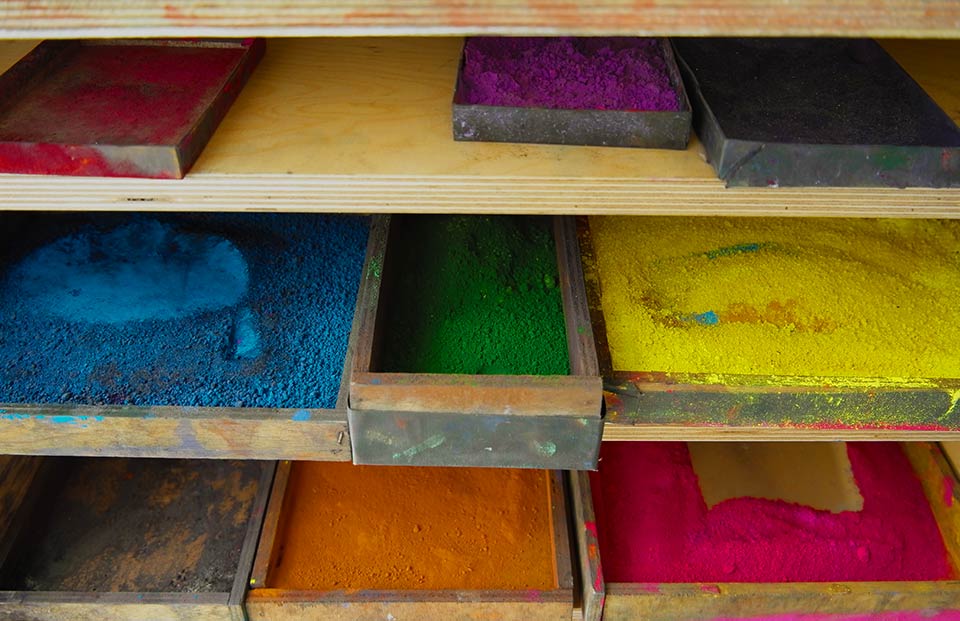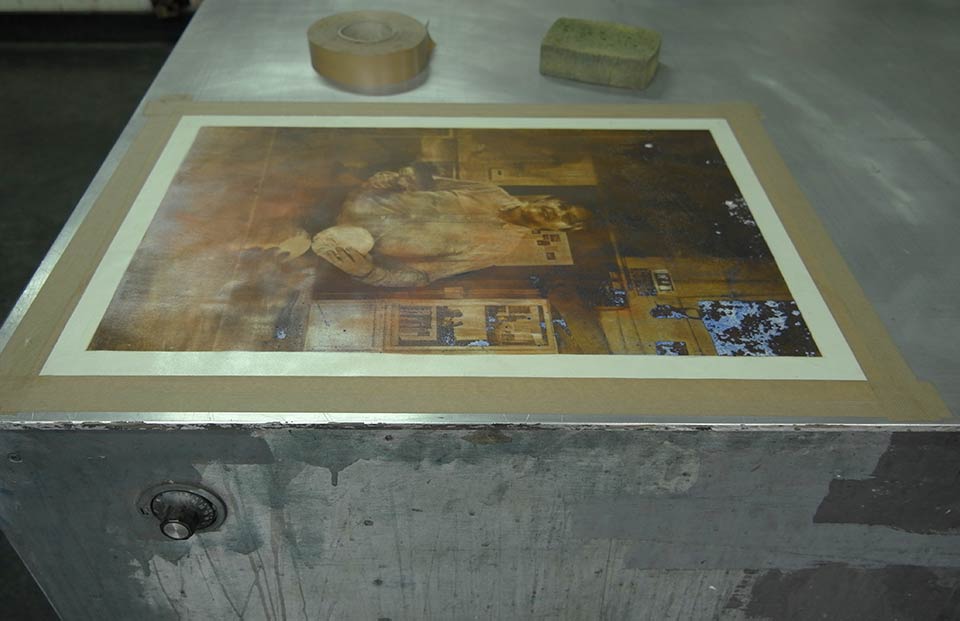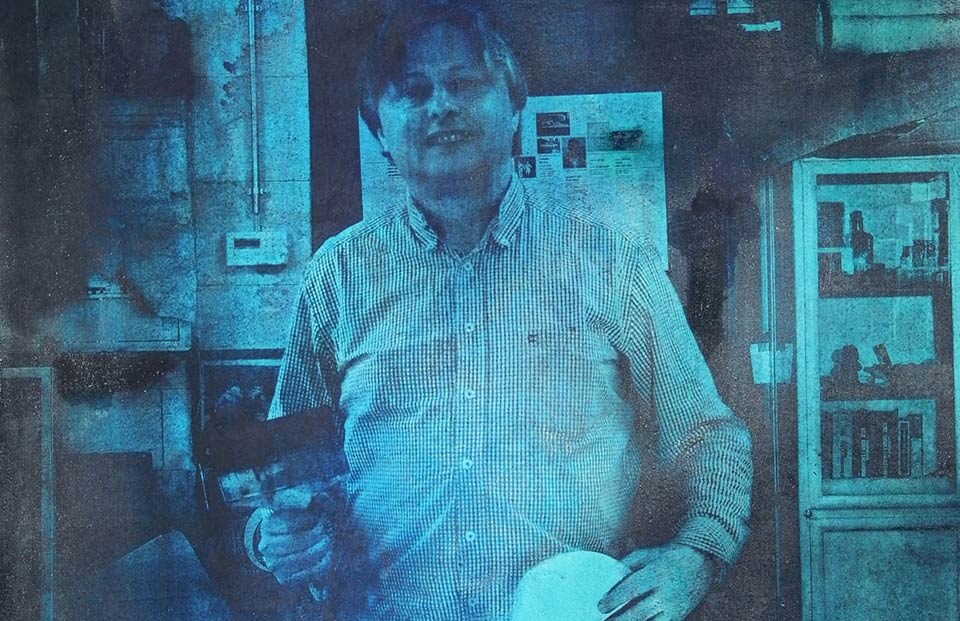
Alfon’s most current work focusses on the relationship between photography and painting by applying pigments. HIs handcraft is the backbone of his art. It is hisdaily ‘discipline’. Due to hygro-atmospheric variables, he is not in control of the whole process but transgressions enable him to reach stunning results.



There is something like a correlation between what his handcraft sets free and what society is able to accept. To him his handcraft means various states of emotion: love for a pursuit which promises salvation, a calling that he wants to exercise every day and the constant struggle of organizing his craft in a way that integrates it into our fast moving world. And this requires endurance. The future of his craft depends on the availability of the material.
Components like negative film, chromium salt, photographic gelatin, etc. are increasingly hard to find and prices are rising with their rarity. But the availability of material does not guarantee success. He highly enjoys the moment when he can start applying the pigments because, in this very moment, all the decisions he had to take before become reality. It’s a true barometer reacting with the soul and the circumstances of this moment. His art is the place where he feels truly connected with the world. When pixels turn into real tangible pieces - this for him is the ultimate feeling.

INTERVIEW

Simply why?
Weil meine Kunst der Ort ist wo ich uneingeschränkt zur Welt kommen kann.
When and where were you born?
Ich bin am 29.09.1962 in Illertissen, Deutschland an der Bayerisch-Würtembergischen Grenze geboren.
Where is your life centered at the moment?
Heute habe ich die Hafen-Stadt Marseille als Ausgangsbasis für alle weiteren Ereignisse meines Lebens gewählt.
Where is your work centered at the moment?
Meine aktuelle Arbeit bezieht sich auf die Beziehung, die die Fotografie mit der Malerei unterhält und dies hauptsächlich mit Anwendung von Pigmenten
How old is your handcraft?
Mein Handwerk hat seine Wurzeln in den ersten Zwanzig Jahren der Geschichte der Fotografie.
How, when and where did your handcraft find you first?
Es ist ein langer Weg, der anfing bei Jean-Pierre & Claudine Sudre in Lacoste (Provence), wo ich das fotografische Grundwissen von der Pique auf erlernt und angefangen habe, mich für historische Verfahren zu interessieren. Aber mit Jordi Guillumet (Barcelona) habe ich wirklich einen Meister gefunden, wo das Handwerk und der Sinn der ganzen Sache mit mir auf einen Punkt gelandet ist.
Is it Love? Profession? Faith? Determination? Curse?
Es ist wohl etwas von allem, Liebe zu einer Beschäftigung die einem Gnade verspricht, Berufung, man will es dann jeden Tag ausführen, und versucht es auf seine Weise zu organisieren und in unsere kurzlebige Zeit einzubauen dies auf Dauer. Und dies erfordert, dass man dauern muss… Ich habe also meine künstlerischen Prokjekte meinem Handwerk untergeordnet.
Please tell us more about the history / origin of your handcraft.
« Pigmentverfahren » gibt es seit dem Anfang der Fotografie: Nicephore Nièpce hat sein Verfahren mit Judäa-Bitumen entdeckt und Alphonse Poitevin ist der Erfinderer der Pigment-verfahren aufgrund der Lichtempfindlichkeit der Chromsalze. Als Poitevin seine Entdeckung 1858 der französischen Gesellschaft für Fotografie (SFP) vorstellte, fügte er hinzu, dass er es nie praktizieren werde, weil er nie zwei identische Exemplare damit herstellen könnte, denn es war nicht industrialisierbar. 1925 hat der Italiener Rodolfo Namias das Verfahren wieder augegriffen und den Prozess in einem Buch erklärt. Er hat in Italien einige Anhänger ( Grupo Rodolfo Namias) die auf Ihre Art sein Erbe weiter führen. Bei mir war die Begegnung mit Michel Bertrand der Kick und Auslöser, in Marseille eine Werkstatt einzurichten, in der diese Verfahren angewendet und experimentiert werden konnten und können. Jetzt habe ich meine Werkstatt in der Friche Belle de Mai, Marseille.
Do you control or change your handcraft or does your handcraft control or change you?
Mein Handwerk ist das Rückgrat meiner Kunst. Sie ist meine « tägliche »Disziplin. Ich kann nicht alles kontrollieren, aufgrund der hygro-atmosphärischen Variabeln, komme aber durch Transgressionen zu erstaunlichen Ergebnissen. Es gibt dann so etwas wie eine Entwicklung zwischen dem was diese Arbeit freisetzt und was die Gesellschaft annimmt und annehmen kann.
How did your craft develop in the course of the past decades or centuries?
Alfons Alt, ok, aber so alt bin ich nun auch wieder nicht…. Im Jahr 2000 habe ich in Arles (Rencontres Internationales de La Photographie) dafür den European Publisher’s Award for Photography gewonnen, und im Anschluss sehr viele Ausstellungen produziert im internationalen Raum.
How will your craft and you evolve together in the future?
Wenn ich es schaffen werde, in Zukunft auch weiterhin noch an meine Rohstoffe für mein Handwerk zu kommen, dann gibt’s auch noch eine Zukunft für dieses Handwerk. Filmmaterial, (Negative , Chromsalze, Fotografische Gelatine,…usw wird immer teurer wenn man sie noch findet…)
Which part of the production process do you like best and why?
Am Liebsten mag ich den Moment des Pigmentierens, weil in diesem Moment alle vorhergehenden Entscheidungen Wirklichkeit werden. Es ist ein richtiger Barometer der Seele und der Umstände in diesem Augenblick.
Which part of the production process is the most tricky one?
Der kniffligste Moment meiner Arbeit ist, wenn ich die Chromsalze vorbereite… Die Dichte dieser Substanz ist vollkommen abhängig von den Hygro-atmosphärischen Bedingungen und das bedeutet, dass man mit allen Augen beobachtet, wie die Chemie funktioniert und sofort reagiert wenn sich die Viskosität verändert.
What is the biggest challenge?
Die grösste Herausforderung stellt sich heraus, wenn alles schief läuft und man muss trotzdem eine Lösung finden, die dann einen auch noch selbst überrascht.
How does it feel to transform digital pixels into real, tangible originals?
Digitale Pixel, die eigentlich sehr virtuel sind, werden in den Werken plötzlich « dasTangible « Originale – Sie werden Wirklichkeit – Das ist das Höchste.
Please define „crazy“
Verrücktheit ist, immer wieder das Gleiche zu tun und andere Ergebnisse zu erwarten! Albert Einstein
History
PIGMENT PRINT
Pigment print evolved together with the rise of photography. In the 1820s Nicephore Nièpce developed a photographic technique using Bitumen of Judea or Syrian Asphalt which was capable of producing durable light-fast results. In 1826 he applied a thin coating of the tar-like material to a pewter plate and took a picture of his estate, producing the first photograph ever. It would be another Frenchman, Alphonse Poitevin, who would discover the light–sensitive properties of bichromated gelatin and invent both the photolithography and collotype processes.
When Poitevin presented his findings to the Photographic Society (SFP) he emphasized that he would never use this technique because it made it impossible to reproduce two identical prints and therefore was not suitable for industrial use. The process was later adapted to color, through the use of pigments, by Louis Arthur Ducos du Hauron in 1868. In 1925 ,Rodolfo Namias continued the technique and described it in his book Manual teórico-práctico de Química Fotográfica. His legacy lives on even today through the work of his followers who formed the Grupo Rodolfo Namias.
Carbon printing remained commercially popular through the first half of the 20th century. It was replaced over time by the dye-transfer process, chromogenic, dye-bleach and, now, digital printing processes. The efficiencies gained through these more modern automated processes relegated carbon printing to the commercial backwaters in the latter half of the 20th century.